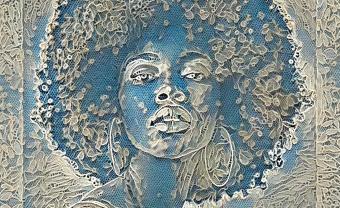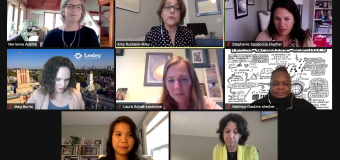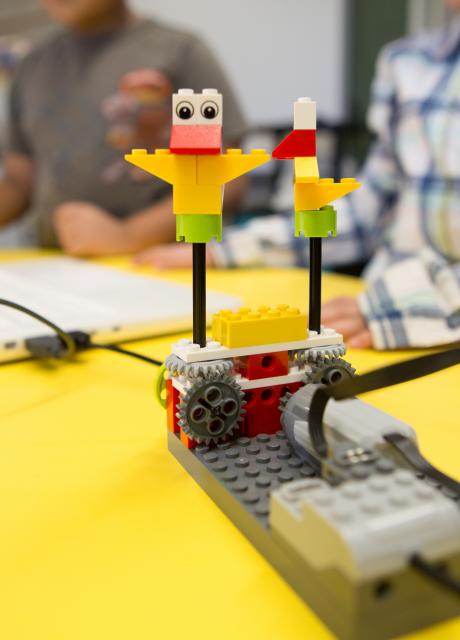Georgia Sparling
This is who we are a podcast of Lesley University that's all about people and their passions. I'm Georgia Sparling, and in every episode, I'll introduce you to someone from our community: a student, a professor, a staff member, or alum who embodies the power of the human arts to uplift, heal, and transform
Nettrice Gaskins
I collaborate with machines to make art.
Georgia
That's Nettrice Gaskins, the assistant director of the STEAM Learning Lab here at Lesley University. Through her work, she's helping to introduce kids to the sciences, tech engineering, the arts, and math, aka STEAM. Her focus is specifically on those kids who are often left out of the conversation. But Nettrice is also a digital artist who creates these amazing, colorful, textured portraits, often of African American artists like Toni Morrison, Ella Fitzgerald, and Shock G. But rather than use something traditional, like paint or charcoal, Nettrice paints with code. And rather than printing her images, she sells them digitally as NFTs. I'll explain more about that later. First, let's talk about her work.
[Music: "Sit down, I can't sit down....I just got to heaven got to walk around…"]
Nettrice sees her art as being in step with the musical tradition of call and response, which was brought to the United States by enslaved Africans and carried on through spirituals, the blues, jazz, and hip hop. Nettrice's work is not so different. But instead of one voice responding to another, it's a dialogue between human and computer.
Nettrice
There's a call, here's the content, and then the response is what the machine produces back. And this can be iterative. This can be looped, so I can continue to say, Okay, this is what you give me back. Well, how about this? And how about this? How about this, until I get that output, that result that I want. People say, "Well, isn't it the computer?" The computers can only do what it does. It's a tool
Georgia
It's a tool Nettrice wasn't interested in as a kid, even though her mother was a computer programmer, a rare job for a Black woman in the 1980s
Nettrice
So she was a bit of a pioneer, at least where I was coming from.
Georgia
Nettrice studied visual arts at a magnet high school in Louisville, Kentucky. It was her ceramics teacher, Mrs. Sidebottom, who convinced Nettrice to take a computer class. It was also Mrs. Sidebottom who predicted that Nettrice would become a teacher, and that computers were going to be a big part of her students' futures. But Nettrice wasn't exactly an early adopter.
Nettrice
I had no interest in math or computers at all. I was reluctant and actually very doubtful that it would be something I'd be interested in. But the fact that she was able to give me another tool to make art was something that I was really into.
Georgia
That one course changed the trajectory of Nettrice's life.
Nettrice
So that led to my major, which was computer graphics at Pratt Institute in New York City.
Georgia
Everyone just assumed she would go the commercial route with graphic design. But that avenue never appealed to Nettrice. She had long been a volunteer at hospitals and in her community.
Nettrice
I had this kind of real need to give back. Eventually, I would just move directly into doing community based work for many years.
Georgia
She started by building a computer graphics lab in the basement of a New York City Housing Development. The students responded well to Nettrice, even those who traditionally had had trouble in classes. Nettrice had found a niche in setting up these learning labs.
Nettrice
I was creating the space as opposed to just walking into spaces. I was interested in this idea of learning environments, and how that can be conducive to engagement with students and with young people. And that's where it began.
Georgia
Nettrice got her MFA in art and technology at the School of the Art Institute of Chicago. Later, she got her PhD in digital media from Georgia Tech. During this time, she never gave up her art, but it did take a backseat to her work in education. Then artificial intelligence, and more specifically, machine learning, gave Nettrice a new way to express herself artistically.
Nettrice
So it came through teaching that I got to start making the images that I make today. So around 2016, I taught AP Computer Science Principles at a high school in Boston for the arts. All 16 students had an arts major. I also wanted to make it culturally relevant to the students that were mostly African American, Latino, mostly girls.
Georgia
History was about to repeat itself. Just as Mrs. Sidebottom had taught her computer graphics, Nettrice was about to teach a group of artsy high schoolers computer science. Although she'd been in education for a while now, this was Nettrice's first formal computer science class as a teacher, and she was pretty sure the students would get bored and just stop showing up. But they kept coming to class. Get too far away from the creative aspects of computer science, and yes, their eyes did glaze over some, but focus on art and they were all in it.
Nettrice
I didn't see myself being a teacher, but here I was teaching AP Computer Science Principles with students who are in a demographic that everyone says is underrepresented and not interested in STEM.
Georgia
During the course, Nettrice discovered an online application that used AI to create images. It was something she and her students could use to make art. And it was the first time in a long time that the Nettrice had found her way back to a regular art practice. The class ended after one year, but Nettrice kept using the AI art application.
Nettrice
So they start off as photographs. Some of them are my photographs. Some of them are stock photos. And you know, some of our photos of people that I know and their work, and I started taking these photos and then there's a whole process in machine learning where there's an algorithm and that algorithm's instructions are to take that source image or the content image and apply a style so you can make that image in the style of Picasso or Van Gogh, or, you know, many other types of artists. And I started to really find kind of a groove, so I trained the machine to recreate these photographs. The results were these kind of very distinctive looking images that people were responding to.
Georgia
By this time, Nettrice was working at the Fab Foundation, a nonprofit that promotes and facilitates innovation and digital fabrication as well as educational opportunities. The foundation had professional quality printers, and so she began to print out some of her images, eventually creating an online gallery and a store for her work. But when the pandemic hit, she found a new way to sell work, this time as NFTs — that's non fungible tokens — and they're kind of hard to explain. Here's the TLDR. NFTs are unique digital assets. Since we're talking about art, think of an NFTs like an original painting. Even though you may be able to buy postcards of that painting at the museum gift shop, there's only one original. When Nettrice put her NFTs up for sale using a blockchain (think Bitcoin although she used a different marketplace) it was just an experiment. A friend had given her a crash course in selling NFTs and $8 and a blockchain currency called Tez. That got her started on an NFT marketplace called hic et nunc, Latin for here and now. Oh...did that clear anything up? Anyway, let's just say Nettrice started with eight bucks, a digital file of her artwork, and in a few minutes, she had her first sale.
Nettrice
So in the first week it went from $8, gifted to me, to that first NFT that's 300 some dollars to $1,000 in a week, to $10,000 and that's in US money.
Georgia
Almost every time Nettrice put an NFT up, it's sold out. Nettrice sees NFTs as a way of opening up a path for more diverse artists to sell their work, artists such as Black women like herself who don't always get recognition for their artwork.
Nettrice
There are many people who have intersectionally been shut out of the official art market and that's gone on for years. So NFTs has the potential to help us make a living or supplement our incomes
Georgia
Selling AI art and NFTs has opened more opportunities for Nettrice. A building in Roxbury has licensed the use of some of her pieces and 11 of her portraits, including a self portrait will appear in the Smithsonian's Futures exhibit that opens in November. All of this started with interdisciplinary arts education that continues to be at the center of how Nettrice thinks about technology and creativity. At the Lesley STEAM Learning Lab, where Nettrice is the assistant director, she's helping to guide current and future teachers in research that will remove disciplinary bubbles and create more equitable, holistic learning. Nettrice's new book brings together all of these ideas. It's called "Techno Vernacular Creativity and Innovation: Culturally Relevant Making Inside and Outside of the Classroom. And it explains both the philosophy of Nettrice's approach and also practical ways to apply it. The goal is to explore more ways to make STEAM and DIY more culturally relevant and inclusive, especially for Black, Indigenous and Latinx learners. Artists like Nettrice do this all the time. In her case, she's using existing photos and reimagining them using machine learning algorithms.
Nettrice
So I'm on a path that no one else is on. So I don't really have a blueprint. I'm taking advantage of opportunities that are there. And if you take the step other people will take the steps, too.
Georgia
Thank you for listening, who we are is a monthly podcast of Lesley University. To learn more about us visit lesley.edu and check out our show notes for more information on today's guest.


